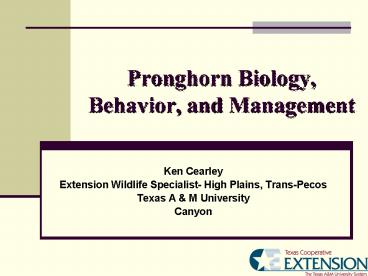Pronghorn Biology, Behavior, and Management PowerPoint PPT Presentation
1 / 31
Title: Pronghorn Biology, Behavior, and Management
1
Pronghorn Biology, Behavior, and Management
- Ken Cearley
- Extension Wildlife Specialist- High Plains,
Trans-Pecos - Texas A M University
- Canyon
2
Objectives
- Overview of pronghorn basic life history
- Reproduction
- Behavior
- Pronghorn habitat requirements
- Management practices
- Emphasis on Panhandle
3
Recommended Resources
- Pronghorn Ecology and Management. Bart W. OGara
and Jim D. Yoakum. 2004. - Common Rangeland Plants of the Texas Panhandle.
NRCS. 2005. - A Handbook for Pronghorn Antelope Management in
Texas. Tommy Hailey, TPWD. 1986. - Pronghorn Management Guide. R. E. Autenrieth, et
al. 2006.
4
Distribution of Pronghorns
TPWD 1986
5
Trans-Pecos Pronghorns
- lt12 precipitation typically
- Vegetation
- Grama grasslands
- Creosote-tarbush shrublands
- Tobosagrass
6
Lower Plains Pronghorns
- 16 precipitation
- Vegetation
- Bluestem
- Buffalograss
- Tobosagrass
- Mesquite
- Lotebush
- catclaw
7
Panhandle Pronghorns
- High Plains
- 15-21 annual precipitation
- Mixed prairie
- Short-grass prairie
- Tall-grass prairie
- Vegetation
- Buffalograss
- Blue grama
- Mesquite
- Sand sage
- Shin oak
- Yucca
8
Panhandle Pronghorns
- Rolling Plains
- 22-30 precipitation
- Tallgrass prairie
- Mid-grass prairie
- Vegetation
- Little bluestem
- Sand bluestem
- Sideoats grama
- Mesquite
- Sand sage
- Shin oak
9
Description
- 70-140 lbs.
- Adult size by 2 years
- Does typically breed year two
- Both sexes horned
- Males have forked horns
- sheath shed annually
- Males have cheek/neck patch
- Abnormally large eyes
- Placement on skull beneficial
- Excellent eyesight
- Long legs- 45 plus mph
10
Physiology
- Thermal regulation by counter-current blood flow
to brain - Cools blood supply
- Maximized airflow- by design
- Lungs
- Diaphragm
- Esophagus
- High hemoglobin concentration in blood
11
Other design features
- Concentrated urine
- Water conserved by concurrent exchange of oxygen
- Water intake reduced by decreasing food intake in
stressful / critical times
12
Reproduction
- Breeding begins late summer
- Polygynous breeders
- Few males breed all adult females
- Resource-defense polygyny
- Resources clumped and predictable
- Female-defense polygyny
- Resources are evenly distributed and
unpredictable - Harems gathered
13
Reproduction
- Breed as early as 16 months
- Breed annually until 8-10 years of age
- Rut onset varies with weather
- Photo-period driven, basically
- Length breeding season
- South- 3 months
- North- 3 weeks
- Does cycle until bred
14
Reproduction
- 250 day gestation
- Nutrition during pregnancy and lactation critical
- 112110 males to females at birth
- Twinning common on healthy rangeland
15
Food Habits
- Nutritional requirements
- Provision depends on availability
- Rainfall
- Competition
- Crop depredation
- Concentrate selectors
- Forbs- rank first in consumption, typically
- more nutrients, in small package
- Forbs high in water content
- Browse ranks second
- 8 of diet is grasses
- Water provided from free-standing, pre-formed,
and metabolic processes
16
Behavior
- Foraging affected by build
- Small frame
- Small organs
- Small mouth, muzzle
- Foraging affected by social behavior
17
Behavior
- Herding
- Tighter as move north
- Selfish herds
- Predator avoidance
- Increases feeding efficiency
- White rump patch makes each individual highly
visible - TX- nomadic
- Farther north- more migratory
- Seasonal movements in response to habitat
- Most move less than 10-20 miles
18
Restrictions to movement
- Fences
- 18 clearance best net wire restricts
- Highways
19
Disease Implications
- Carriers of abortive diseases?
- Brucellosis?
- Leptosirosis?
- IBR?
- 10 years of sampling by TPWD 1060-1970
- N827
- No brucellosis
- No lepto
- N75 IBR
- 5 false positives, end result- no IBR
20
Management
- Inventory
- Aerial
- Mid to late summer, usually
- Strip flying
- Some important parameters
- Total count
- DoeFawn ratio
- Exceptional animals
- Overall range and animal condition
21
Management
- Harvest
- Permit issuance determined by TPWD
- Surplus taken if necessary to maintain carrying
capacity - Parameters
- Age
- 4 1/3 years best horns
- 12 buckdoe ratio conducive
- 14 more conducive to larger number young animals
- Habitat conditions
- Carrying capacity
- Objectives and goals
22
Aging Pronghorns
- Fawns
- Short jaw length
- Molars not fully erupted
- Yearling
- 1 yr 4 mos
TPWD
23
Aging Pronghorns
- 2 yrs 4 mos
TPWD
24
Aging Pronghorns
- 3 yrs 4 mos
TPWD
25
Aging Pronghorns
- 4 yrs 4 mos
TPWD
26
Aging Pronghorns
- 8 yrs 4 mos
TPWD
27
Management
- Keep watering facilities functional
- Maintain range condition to provide adequate food
supply - Fawning cover
- Thwarts predation efforts
- Adequate nutrition
- Especially during spring and summer when peak
demands from gestation, then lactation
28
Management
- Provide unrestricted movement
- Pronghorn friendly fencing
29
Management
- Deter crop depredation
30
Management
- Supplemental feeding
- May be beneficial in nutritionally stressful
periods - Feed not readily accepted
31
Summary
- Inventory
- Plan the harvest
- TPWD determines permit issuance
- Monitor range condition and pronghorn condition
to determine carrying capacity - Maintain water even when livestock not present,
including breaking ice - Fencing conducive to goals
- Restriction or movement
- Age determination of harvested animals
- Utilize supplemental feeding as required
- Manage predators when necessary (coyotes
primarily) - Maintain good range condition to provide physical
protection (thermal, predation) and food
requirements.

